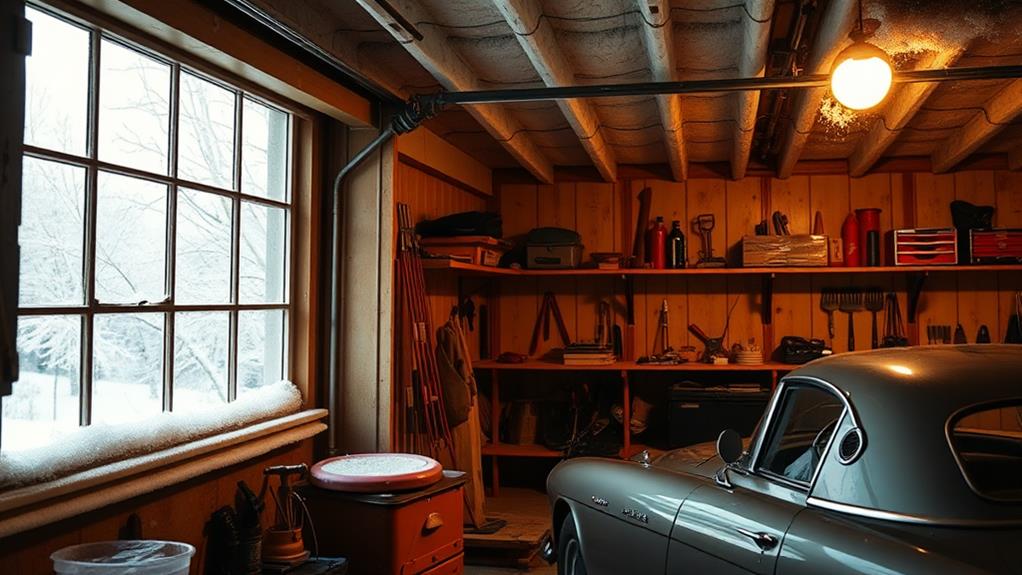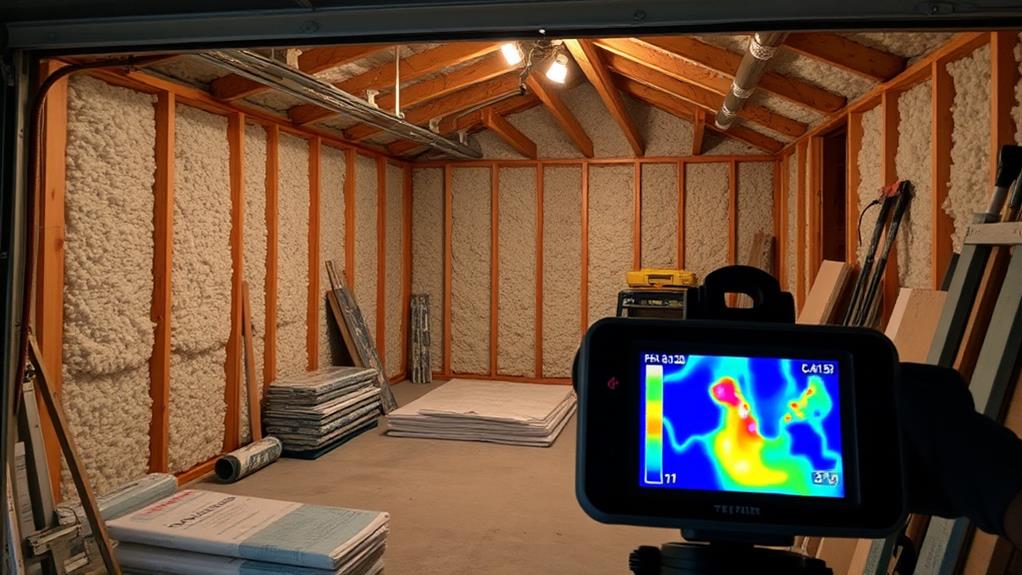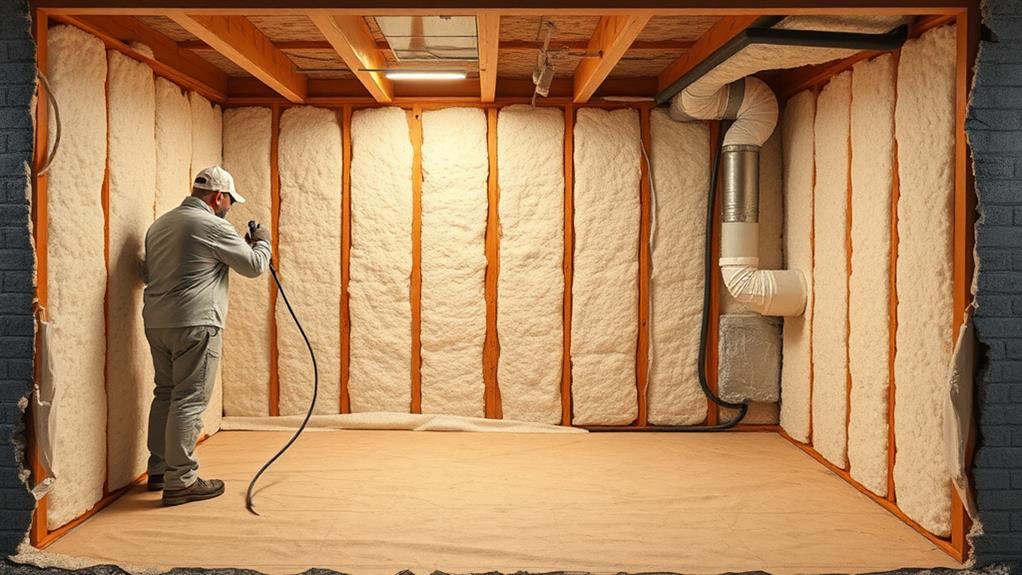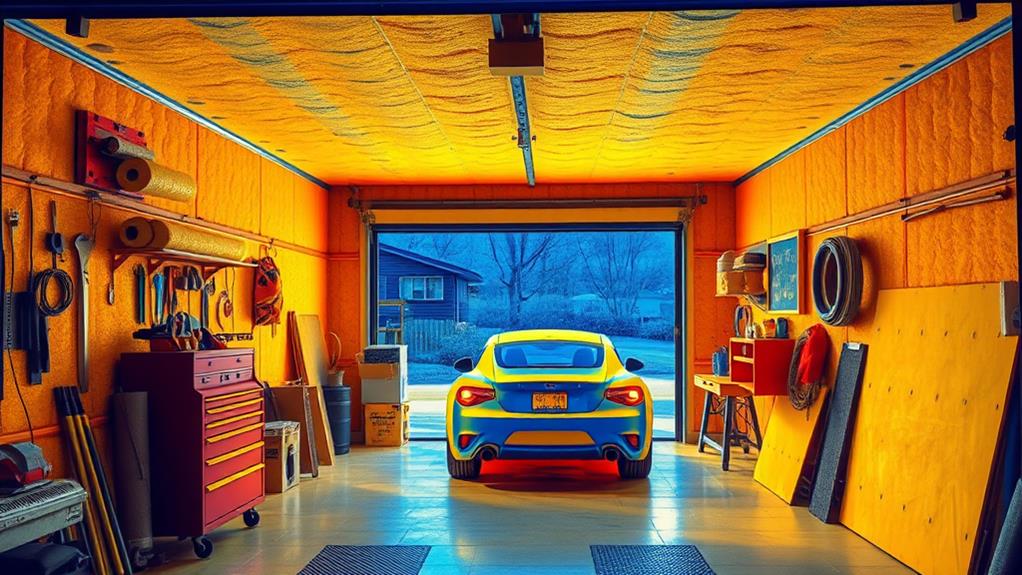Insulating your garage and other unheated spaces can significantly improve your home's comfort and energy efficiency. You'll create a more comfortable environment, protect stored items, and reduce energy costs by preventing heat loss. Start by assessing your insulation needs, considering the space's use and your budget. Choose from materials like fiberglass batts, spray foam, or rigid foam boards. For garages, seal air leaks, insulate walls and doors, and address the ceiling if necessary. Don't forget about basements and crawl spaces, which require special attention to moisture control. By understanding the process and benefits, you'll be well-equipped to tackle this valuable home improvement project.
Benefits of Insulating Unheated Spaces

While many homeowners focus on insulating their main living areas, extending this practice to unheated spaces like garages can yield significant benefits. By insulating your garage, you'll create a more comfortable environment for various activities, from car maintenance to DIY projects. You'll also protect your vehicles and stored items from extreme temperature fluctuations, which can cause damage over time.
Insulating unheated spaces helps reduce energy costs by preventing heat loss from adjacent living areas. This is especially important if your garage shares walls with your home. You'll notice a difference in your heating bills, as your HVAC system won't have to work as hard to maintain a consistent temperature.
Another advantage is noise reduction. Insulation acts as a sound barrier, minimizing both external noise entering your home and internal noise escaping to your neighbors. This is particularly beneficial if you use your garage as a workshop or hobby space.
Lastly, insulating unheated spaces can increase your home's overall value. Potential buyers often view well-insulated garages and other utility areas as desirable features, making your property more attractive in the real estate market.
Types of Insulation Materials
When you're ready to insulate your garage or other unheated spaces, you'll find several types of insulation materials available. The most common options include fiberglass batts, spray foam, and rigid foam boards.
Fiberglass batts are cost-effective and easy to install. They come in pre-cut panels that fit between wall studs and ceiling joists. For optimal performance, choose batts with a vapor barrier to prevent moisture buildup.
Spray foam insulation offers excellent air sealing properties and can be applied to irregular surfaces. It comes in two types: open-cell and closed-cell. Open-cell is more affordable but less effective, while closed-cell provides superior insulation and moisture resistance.
Rigid foam boards are versatile and can be used on walls, ceilings, and floors. They're available in different thicknesses and R-values, allowing you to choose the best option for your needs. These boards are easy to cut and install, making them ideal for DIY projects.
Other insulation options include cellulose, mineral wool, and reflective foil. Cellulose is eco-friendly and made from recycled paper products. Mineral wool offers fire resistance and soundproofing benefits. Reflective foil works well in hot climates by reducing radiant heat transfer.
Assessing Your Insulation Needs

Before you start insulating your garage or unheated space, it's crucial to assess your specific insulation needs. Begin by examining the current state of your space, noting any existing insulation and areas where heat loss is most significant. Check for drafts, gaps, and areas of condensation, as these indicate problem spots.
Consider the space's primary use and how much time you'll spend there. If it's a workshop or frequently used area, you'll want higher insulation levels than for a simple storage space. Evaluate your local climate, as colder regions require more robust insulation.
Measure the dimensions of your walls, ceiling, and floor to calculate the total area you'll need to insulate. This will help you determine material quantities and costs. Don't forget to factor in any windows, doors, or other openings that may need special attention.
Assess your budget and long-term energy saving goals. While higher-quality insulation may cost more upfront, it can lead to significant savings over time. Finally, check local building codes and regulations to ensure your insulation plans comply with safety standards and requirements.
Steps for Garage Insulation
A well-planned approach is key to successfully insulating your garage. Start by sealing any air leaks around windows, doors, and other openings. Use weatherstripping and caulk to close these gaps, preventing drafts and improving energy efficiency.
Next, insulate the walls. If they're unfinished, install fiberglass batts between the studs, ensuring a snug fit. For finished walls, consider blown-in cellulose insulation or foam board. Don't forget to insulate the garage door, which is often a major source of heat loss. Use a garage door insulation kit or attach rigid foam panels.
Address the ceiling if there's living space above. Install fiberglass batts or blown-in insulation between the joists. If the garage is detached, insulate the roof to prevent heat escape through the attic.
Consider the garage floor, especially if it's in contact with the ground. Install a vapor barrier and rigid foam insulation before pouring a new concrete slab, or add interlocking foam tiles over existing concrete.
Insulating Basements and Crawl Spaces

Basements and crawl spaces present unique challenges for insulation. These areas are often damp, prone to moisture issues, and can be a major source of heat loss in your home. To insulate them effectively, you'll need to address both air sealing and moisture control.
For basements, start by sealing any cracks or gaps in the foundation walls and floor. Then, install a vapor barrier on the walls before adding insulation. Rigid foam boards are an excellent choice for basement walls, as they're moisture-resistant and provide a high R-value.
For the floor, consider using spray foam insulation or rigid foam boards covered with a subfloor.
In crawl spaces, begin by ensuring proper drainage and installing a vapor barrier on the ground. Insulate the walls with rigid foam boards, making sure to cover the rim joists as well. If your crawl space has vents, consider sealing them and insulating the floor above instead.
Don't forget to insulate any pipes or ducts in these spaces to prevent heat loss and freezing. By properly insulating your basement or crawl space, you'll improve your home's energy efficiency and comfort while reducing the risk of moisture-related problems.
Cost Considerations and Energy Savings
When considering insulation projects for unheated spaces, it's crucial to weigh the costs against potential energy savings. You'll need to factor in materials, labor, and any additional work required, such as vapor barriers or ventilation improvements. Insulation costs vary widely depending on the type and thickness you choose, with fiberglass batts being the most affordable and spray foam the most expensive.
To estimate potential savings, assess your current energy bills and the temperature difference between the unheated space and adjacent living areas. The greater this difference, the more you'll save by insulating. Remember that insulating attached garages can reduce heat loss from your home's walls and floors, potentially lowering your heating bills by 5-10%.
While upfront costs may seem high, you'll often recoup your investment through energy savings within 3-5 years. Don't forget to check for local rebates or tax incentives that can offset your expenses. By properly insulating unheated spaces, you're not only saving money but also improving your home's comfort and reducing its environmental impact.
Conclusion
You've now got the tools to transform your unheated spaces into comfortable, energy-efficient areas. Isn't it time to stop wasting energy and money? By insulating your garage, basement, or crawl space, you'll create more usable living areas while reducing your utility bills. Remember, the right insulation materials and proper installation are key. Don't hesitate to consult professionals if you're unsure. With a well-insulated home, you'll enjoy comfort and savings for years to come.

